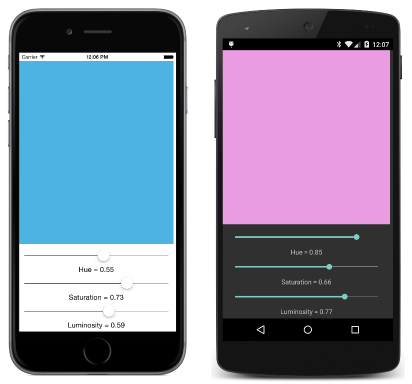Summary of Chapter 18. MVVM
Note
This book was published in the spring of 2016, and has not been updated since then. There is much in the book that remains valuable, but some of the material is outdated, and some topics are no longer entirely correct or complete.
One of the best ways to architect an application is by separating the user interface from the underlying code, which is sometimes called the business logic. Several techniques exist, but the one that is tailored for XAML-based environments is known as Model-View-ViewModel or MVVM.
MVVM interrelationships
An MVVM application has three layers:
- The Model provides underlying data, sometimes through files or web accesses
- The View is the user interface or presentation layer, generally implemented in XAML
- The ViewModel connects the Model and the View
The Model is ignorant of the ViewModel and the ViewModel is ignorant of the View. These three layers generally connect to each other using the following mechanisms:

In many smaller programs (and even larger ones), often the Model is absent or its functionality is integrated into the ViewModel.
ViewModels and data binding
To engage in data bindings, a ViewModel must be capable of notifying the View when a property of the ViewModel has changed. The ViewModel does this by implementing the INotifyPropertyChanged interface in the System.ComponentModel namespace. This is part of .NET rather than Xamarin.Forms. (Generally ViewModels attempt to maintain platform independence.)
The INotifyPropertyChanged interface declares a single event named PropertyChanged that indicates the property that has changed.
A ViewModel clock
The DateTimeViewModel in the Xamarin.FormsBook.Toolkit library defines a property of type DateTime that changes based on a timer. The class implements INotifyPropertyChanged and fires the PropertyChanged event whenever the DateTime property changes.
The MvvmClock sample instantiates this ViewModel and uses data bindings to the ViewModel to display updated date and time information.
Interactive properties in a ViewModel
Properties in a ViewModel can be more interactive, as demonstrated by the SimpleMultiplierViewModel class, which is part of the
SimpleMultiplier sample. The data bindings provide multiplicand and multiplier values from two Slider elements and display the product with a Label. However, you can make extensive changes to this user interface in XAML with no consequent changes to the ViewModel or the code-behind file.
A Color ViewModel
The
ColorViewModel in the Xamarin.FormsBook.Toolkit library integrates the RGB and HSL color models. It is demonstrated in the HslSliders sample:
Streamlining the ViewModel
The code in ViewModels can be streamlined by defining an OnPropertyChanged method using the CallerMemberName attribute, which obtains the calling property name automatically. The ViewModelBase class in the Xamarin.FormsBook.Toolkit library does this and provides a base class for ViewModels.
The Command interface
MVVM works with data bindings, and data bindings work with properties, so MVVM seems to be deficient when it comes to handling a Clicked event of a Button or a Tapped event of a TapGestureRecognizer. To allow ViewModels to handle such events, Xamarin.Forms supports the command interface.
The command interface manifests itself in the Button with two public properties:
Commandof typeICommand(defined in theSystem.Windows.Inputnamespace)CommandParameterof typeObject
To support the command interface, a ViewModel must define a property of type ICommand that is then data bound to the Command property of the Button. The ICommand interface declares two methods and one event:
- An
Executemethod with an argument of typeobject - A
CanExecutemethod with an argument of typeobjectthat returnsbool - A
CanExecuteChangedevent
Internally, a ViewModel sets each property of type ICommand to an instance of a class that implements the ICommand interface. Through the data binding, the Button initially calls the CanExecute method, and disables itself if the method returns false. It also sets a handler for the CanExecuteChanged event and calls CanExecute whenever that event is fired. If the Button is enabled, it calls the Execute method whenever the Button is clicked.
You might have some ViewModels that predate Xamarin.Forms, and these might already support the command interface. For new ViewModels intended to be used only with Xamarin.Forms, Xamarin.Forms supplies a Command class and a Command<T> class that implement the ICommand interface. The generic type is the type of the argument to the Execute and CanExecute methods.
Simple method executions
The PowersOfThree sample demonstrates how to use the command interface in a ViewModel. The PowersViewModel class defines two properties of type ICommand and also defines two private properties that it passes to the simplest Command constructor. The program contains data bindings from this ViewModel to the Command properties of two Button elements.
The Button elements can be easily replaced with TapGestureRecognizer objects in XAML with no code changes.
A calculator, almost
The AddingMachine sample makes use of both the Execute and CanExecute methods of ICommand. It uses an AdderViewModel class in the Xamarin.FormsBook.Toolkit library. The ViewModel contains six properties of type ICommand. These are initialized from the Command constructor and Command constructor of Command and the Command<T> constructor of Command<T>. The numeric keys of the adding machine are all bound to the property that is initialized with Command<T>, and a string argument to Execute and CanExecute identifies the particular key.
ViewModels and the application lifecycle
The AdderViewModel used in the AddingMachine sample also defines two methods named SaveState and RestoreState. These methods are called from the application when it goes to sleep and when it starts up again.
